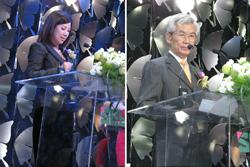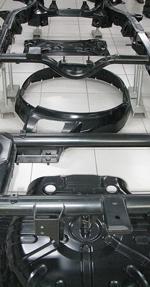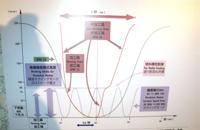Senior Editor
- FMA
- The Fabricator
- FABTECH
- Canadian Metalworking
Categories
- Additive Manufacturing
- Aluminum Welding
- Arc Welding
- Assembly and Joining
- Automation and Robotics
- Bending and Forming
- Consumables
- Cutting and Weld Prep
- Electric Vehicles
- En Español
- Finishing
- Hydroforming
- Laser Cutting
- Laser Welding
- Machining
- Manufacturing Software
- Materials Handling
- Metals/Materials
- Oxyfuel Cutting
- Plasma Cutting
- Power Tools
- Punching and Other Holemaking
- Roll Forming
- Safety
- Sawing
- Shearing
- Shop Management
- Testing and Measuring
- Tube and Pipe Fabrication
- Tube and Pipe Production
- Waterjet Cutting
Industry Directory
Webcasts
Podcasts
FAB 40
Advertise
Subscribe
Account Login
Search
Taiwan’s river of commerce
The small island’s manufacturing powerhouse exemplifies global interconnection
- By Tim Heston
- January 7, 2013
- Article
- Bending and Forming

Figure 1: At dusk stands the entrance to a Confucian temple in Kueisan, Taoyuan County, Taiwan. A few blocks away are clusters of small manufacturers, food markets, electronics retailers, banking centers, and shopping malls.
I could sense the awe and appreciation in the exhibit hall, the one with subdued lighting, tucked away in a corner of the National Palace Museum in Taipei, a landmark of Taiwan’s capital city that houses treasures from the Chinese mainland. People of various Asian ethnicities stood by an exquisite painting titled “Up the River During Qingming.” Shen Yuan, an 18th century Chinese artist, used a ruled-line, almost monochromatic drawing technique on a scroll almost 40 feet long.
A river flows throughout the work, on which Shen painted a seemingly endless stream of unique details: children at play here, a marketplace there, a conversation here, people walking among cherry trees there. Change seems ever constant along the riverbanks, but the river itself flows steadily. The river anchors everything.
Several dozen miles away in San Chong City, a district of New Taipei City, one of the principal industrial areas on the island, the steady cadence of a rail transfer system press line churns away at Cheng Fwa Industrial Co. Ltd. At this plant, six rows of eight SEYI C-frame presses ranging from 160 to more than 200 metric tons stamp enclosures for electrical components. A worker stacks blanks at one end, and the transfer system carries workpieces through four dies; a robotic mechanism then flips the parts for processing through the remaining four stations. At the end, workers insert remaining hardware and perform quality checks. From stamping through assembly, parts cleaning, label printing, and final assembly, it takes a part about an hour to make it through the plant, from coil or blank to the shipping containers.
Like the river on Shen Yuan’s scroll, the work flows steadily via automation, which the company has utilized for the past 15 years, and closely coordinated workers. All this happens every day at a company founded in 1964. The stamper has thrived throughout decades of change on the island, a period when Taiwan reinvented itself several times over.
Ever-constant Change
Cheng Fwa and the metal stampers and fabricators like it launched their shops decades before Taiwan had free elections. The people who started up manufacturing businesses in the 1950s and 1960s grew their companies and, through close partnerships with nearby manufacturers (so-called “clusters”), made Taiwan’s manufacturing base a major player on the global stage.
One such entrepreneur, S.H. Kuo, launched his business two years before Cheng Fwa got off the ground. Like most others, Kuo started small, designing and building mechanical presses. That company eventually grew into a global machine tool manufacturer, Shieh Yih Machinery Industry Co., or SEYI, as it’s known stateside.
In early November the company invited business leaders and members of the media (including one FABRICATOR reporter) to Taiwan to celebrate 50 years in the business. The founder, now retired, stood with the current chairman and CEO, Claire Kuo, his daughter, on a stage flooded with lights. Both father and daughter gave similar, almost self-effacing smiles as they expressed their appreciation and accepted accolades from local officials and global customers (see Figure 1).
About the size of Denmark, Taiwan is a manufacturing powerhouse. Like in the U.S., small and medium-size manufacturers dominate Taiwan, but they aren’t relegated to industrial districts. On just a brief walk around SEYI’s hometown of Kueisan, Taoyuan County, I saw at least four small metal fabricators sprinkled among electronics retailers, food markets, and Confucian and Buddhist temples.
On one side street I heard the crackle of a deep fryer at an outdoor food stand and then, a few steps away, the buzz of a welding arc at a small fabrication shop next door. About a quarter mile away I saw an elementary school, clean and landscaped, right next to a Confucian temple, where students and adults alike burned incense and bowed quietly in prayer.
History and Politics
The years following World War II sent Taiwan through a political maelstrom. Taiwan had been a Japanese colony before the war. But after the allied victory in 1945, the Republic of China, then in Beijing, claimed Taiwan; several years later the ROC fled to Taiwan after Mao’s Communist Revolution took hold on the mainland.

Figure 2: Shieh Yih Machinery CEO and Chairman Claire Kuo (left) and her father, company founder S.H. Kuo, give speeches at the company’s 50th anniversary event.
For decades politics on Taiwan focused on a singular goal: to recover the homeland across the Taiwan Strait. Taiwan, it was thought, would be the ROC government’s temporary home. With the Cold War raging in the 1950s and 1960s, the U.S. didn’t yet recognize Mao’s communist regime on the mainland—that is until Richard Nixon opened up relations in the early 1970s.
Ever since then ties between the U.S. and Taiwan have been close, productive, and important, but also unique, thanks to the global political situation. To this day Taiwan does not have a seat at the United Nations. It has no formal embassy in Washington, though it does have an influential, de facto embassy in D.C. called the Taiwan Economic and Cultural Representative Office. The U.S. has something similar in Taipei, called the American Institute in Taiwan.
Clusters of Productivity
Through all the political turmoil, business growth on the island, much like the river’s flow in Shen Yuan’s scroll, has continued unabated. Driving the flow has been close networks and business ties. Collaboration and trust are the bedrock of commerce.
Today’s titans of finance regularly travel to Taipei, but it wasn’t always this way. Decades ago, before formal credit was widely available to many on the island, entrepreneurs collaborated to form something known as hui. As described by Shelley Rigger in her 2011 book, Why Taiwan Matters, hui represents collaboration between an entrepreneur and his or her friends and family in which everyone contributes to a kitty to raise funds. Such loans led to early manufacturing businesses that formed into clusters of small factories, all serving similar or identical supply chains.
As Rigger explained, “Clustering small firms for joint manufacturing promoted cooperation among relatives, schoolmates, and friends. It also promoted flexibility and minimized marketing costs. SMEs [small and medium-size enterprises] learned to retool quickly to meet the demand for new products. Often, a whole cluster could get by with sending one representative to trade shows to collect orders from foreign buyers. By keeping their business within close-knit networks, Taiwanese entrepreneurs were able to minimize risk while sharing know-how and capital.”
Collaboration also is why Taiwanese manufacturers were one of the first to penetrate the Chinese market. Until the late 1980s Taiwanese weren’t even allowed to visit the mainland (though many evaded the rules). But as soon as policies shifted in 1987, Taishang (Taiwanese entrepreneurs) opened up factories on the mainland, formed new networks and relationships, and, despite the tenuous political environment, drove commerce forward.
High-value Manufacturing
Chien Hsin Chieh, a plant manager at Wuu Shiang Industrial Co. in Chung Li City, pointed to a chassis component on display outside the third-floor conference room (see Figure 2). It was made of high-strength material, 980 MPa. The form was precise, with no wrinkling; the trimmed edge was clean.
The manufacturer has built a reputation for stamping high-strength steels. The company supplies parts to Ford, Toyota, and other OEMs around the globe, and has operated plants in China since 1995. In one of its factories in Taiwan, parts flow from several large, straight-side SEYI presses (for blanking, forming, trimming, and holemaking) before moving to a conveyor, which transports stamped components to an automated welding cell. Robot arms pick and place the workpieces into custom jigs, resistance weld them, then set subassemblies onto returnable containers. With little human intervention, parts are welded and ready for shipment.
At another Wuu Shiang plant in Taiwan, robots transfer sheets of different gauges from a blanking line to another robotized operation, where an articulating arm uses upper and lower rollers to perform resistance seam welding.
Taiwanese manufacturing has become more automated, especially since the opening of the Bamboo Curtain and the availability of cheap labor across the Strait (though that labor isn’t as cheap as it once was). According to Rigger, “hollowing out” of the Taiwanese manufacturing base has become a hot-button political issue. “The customer is the boss, and price-sensitive clients have forced many firms to move production to China when they might have preferred to remain in Taiwan. Despite these fears, Taiwan’s economy seems so far to have benefited more than it has lost, as successes in the mainland increase wealth on the island and stimulate demand for research and development and other Taiwan-based inputs.”

Figure 3: Chassis components on display at Wuu Shiang Industrial Co. show the manufacturer’s expertise in stamping and welding high-strength material.
Toshiharu Suganuma’s presentation exemplified this at SEYI’s anniversary celebration. Standing before a large audience of customers, government officials, industry partners, and employees, the company’s vice president of the forming engineering division pointed to a PowerPoint slide showing different press-stroke curves—all made possible by the servo press. Every curve showed various dwell times at bottom dead center, as well as different stroke heights. The servomotor makes the press ram a controllable axis, which in turn brings numerous forming possibilities. Forms may be accomplished in fewer stations. And with a controllable dwell time at the bottom of the stroke, more secondary operations can be performed in the die (see Figure 3).
Like most businesses in Taiwan, SEYI has benefited from China’s enormous growth in recent decades. The volume of presses sold on the mainland, where SEYI has a large factory to support the demand, allowed the company to expand and pour more money into R&D. But it hasn’t been just about China, of course. SEYI and other Taiwanese manufacturing firms are global. Representatives from around the world—Europe, U.S., Mexico, and elsewhere—attended the press manufacturer’s November event.
Although its GDP growth has slowed (along with other Asian economies), the island remains an active democracy with a modern economy that has become a keystone in many global supply chains. As just one example, Rigger explained how a 1999 power outage blacked out Taiwan’s high-tech corridor for a day, which in the short term nearly doubled the price of computer memory chips.
Taiwan exemplifies the global experience. It is a cultural melting pot. Most of its 23 million souls speak Mandarin, but many groups still speak dialects heard on the island for centuries. Other Austronesian people with their own languages have called Taiwan their home far longer. At the same time, commerce and culture connect them all to the outside world. Drama on the world’s political stage may never cease, but Taiwan is proof that a river of global trade can continue flowing through it all.
Back at Cheng Fwa Industrial, Assistant General Manager C.Z. Li made a sweeping gesture, showing how products flow across the plant floor. The facility is shaped like a big U. On the first leg are engineering and R&D; then prototyping, including a turret punch press, laser cutting center, and a bank of press brakes and hardware-insertion machines. Throughout the U’s trough sit the company’s numerous C-frame stamping presses; then in the final leg comes parts cleaning, label printing, assembly, packaging, and shipping.
Near the end of the process, just outside the door, sits something one won’t likely see at any stateside stamper: a small temple, where the company owner and others can ask for protection, good health, and prosperity (see Figure 4). In this global economy, Taiwan has enjoyed all three.
About the Author

Tim Heston
2135 Point Blvd
Elgin, IL 60123
815-381-1314
Tim Heston, The Fabricator's senior editor, has covered the metal fabrication industry since 1998, starting his career at the American Welding Society's Welding Journal. Since then he has covered the full range of metal fabrication processes, from stamping, bending, and cutting to grinding and polishing. He joined The Fabricator's staff in October 2007.
subscribe now

The Fabricator is North America's leading magazine for the metal forming and fabricating industry. The magazine delivers the news, technical articles, and case histories that enable fabricators to do their jobs more efficiently. The Fabricator has served the industry since 1970.
start your free subscription- Stay connected from anywhere

Easily access valuable industry resources now with full access to the digital edition of The Fabricator.

Easily access valuable industry resources now with full access to the digital edition of The Welder.

Easily access valuable industry resources now with full access to the digital edition of The Tube and Pipe Journal.
- Podcasting
- Podcast:
- The Fabricator Podcast
- Published:
- 04/16/2024
- Running Time:
- 63:29
In this episode of The Fabricator Podcast, Caleb Chamberlain, co-founder and CEO of OSH Cut, discusses his company’s...
- Industry Events
16th Annual Safety Conference
- April 30 - May 1, 2024
- Elgin,
Pipe and Tube Conference
- May 21 - 22, 2024
- Omaha, NE
World-Class Roll Forming Workshop
- June 5 - 6, 2024
- Louisville, KY
Advanced Laser Application Workshop
- June 25 - 27, 2024
- Novi, MI
































